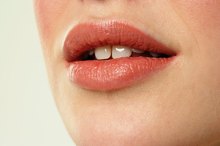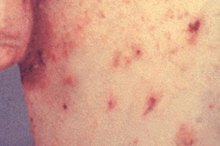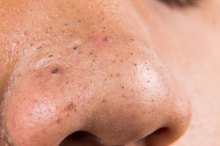How to Use Ginger Topically For Fat Burning
Ginger, or zingiber officinale, is the root of a plant native to China and India. When ingested, according to Dr. Linda B. White, author of “The Herbal Drugstore,” it can increase the metabolism and assist with fat burning. As a topical treatment it is not as affective, but it can help reduce the appearance of subcutaneous fat—fat under the skin. Valerie Ann Worwood, author of “The Complete book of Essential Oils and Aromatherapy,” suggests a blend of ginger essential oil, with other oils, in a nightly massage and bath soak to encourage fat loss 1.
Pour 2 tbsp. almond oil into a ceramic dish. Add 10 drops of carrot oil. Swirl the dish to blend the two oils together.
The Best Way to Get Rid of Sagging Eyelids & Frown Lines Between Eyes
Learn More
Add 15 drops ginger, 10 drops lemon and five drops cypress essential oils to the dish. Swirl the dish, then add five drops juniper essential oil and swirl again.
Dip your fingers into the dish and massage the oil into your problem areas.
How to Treat Acne Cysts
Learn More
Run a warm bath. Add 15 drops ginger, 10 drops lemom, five drops of cypress and five drops of juniper essential oils to the bath water.
Soak for at least 20 minutes and massage your problem areas. Add more hot water, if desired.
Pat yourself dry with a thick towel. Repeat every night for 30 days.
Tips
If you do not wish to take a bath each night, reduce the bath frequency to once a week but massage the oil into your problem areas each night.
Essential oils can irritate the skin. Always mix essential oils with a vegetable-based carrier oil before applying to the skin.
Those with nut allergies can substitute grapeseed, jojoba or olive oil for almond oil.
Warnings
Avoid getting the oils into your eyes.
Related Articles
References
- "The Complete Book of Essential Oils & Aromatherapy;" Valerie Ann Worwood;1991
- "The Herbal Drug Store"; Linda B. White, M.D. and Steven Foster; 2000
- de Groot AC, Schmidt E. Essential oils, part IV. Contact allergy. Dermatitis. 2016;27(4):170-175. doi:10.1097/DER.0000000000000197
- Posadzki P, Alotaibi A, Ernst E. Adverse effects of aromatherapy: a systematic review of case reports and case series. International Journal of Risk and Safety in Medicine. 2012;24(3):147-161.
- University of Minnesota. How do I choose and use essential oils?
- University of Minnesota. Are essential oils safe?
- Nath S, Pandey C, Roy D. A near fatal case of high dose peppermint oil ingestion- Lessons learnt. Indian J Anaesth. 2012;56(6):582-. doi:10.4103/0019-5049.104585
- The Royal Children’s Hospital Melbourne. Essential oil poisoning. Updated June 2017.
- Bowles, Joy E. Case study – possible interaction of herbal sleep remedy containing Lavender essential oil and anxiolytic drugs. Updated 2018.
Tips
- If you do not wish to take a bath each night, reduce the bath frequency to once a week but massage the oil into your problem areas each night.
- Essential oils can irritate the skin. Always mix essential oils with a vegetable-based carrier oil before applying to the skin.
- Those with nut allergies can substitute grapeseed, jojoba or olive oil for almond oil.
Warnings
- Avoid getting the oils into your eyes.
Writer Bio
Julia Michelle has been writing professionally since January 2009. Her specialties include massage therapy, computer tech support, land and aquatic personal training, aquatic group fitness and Reiki. She has an Associate in Applied Science from Cincinnati State Technical and Community College in integrative medical massage therapy.









